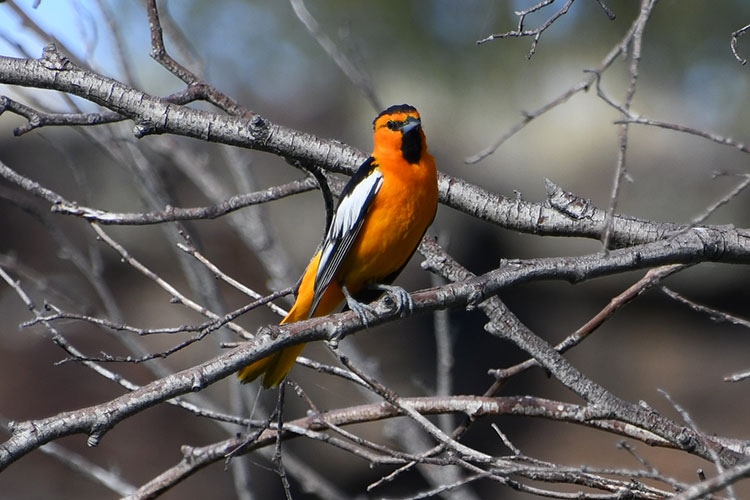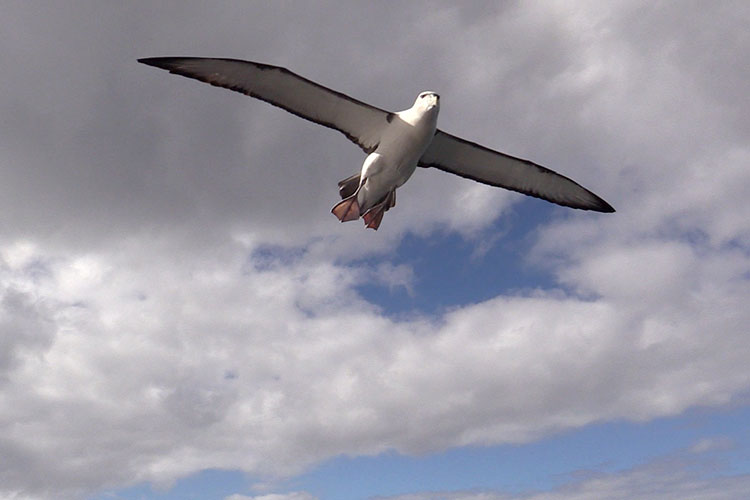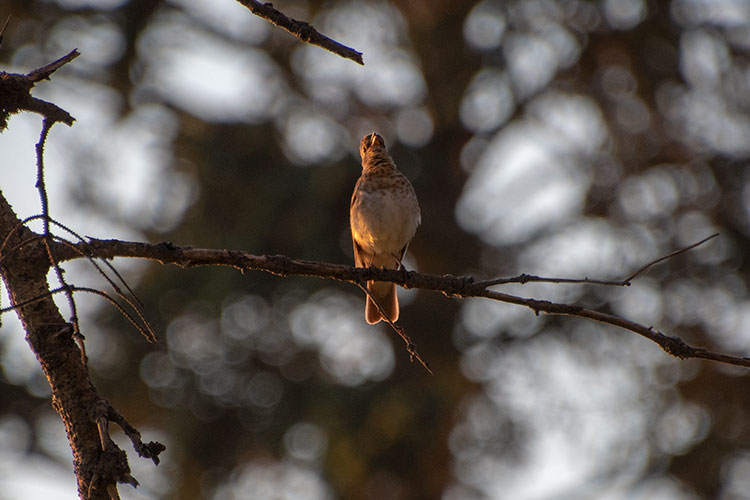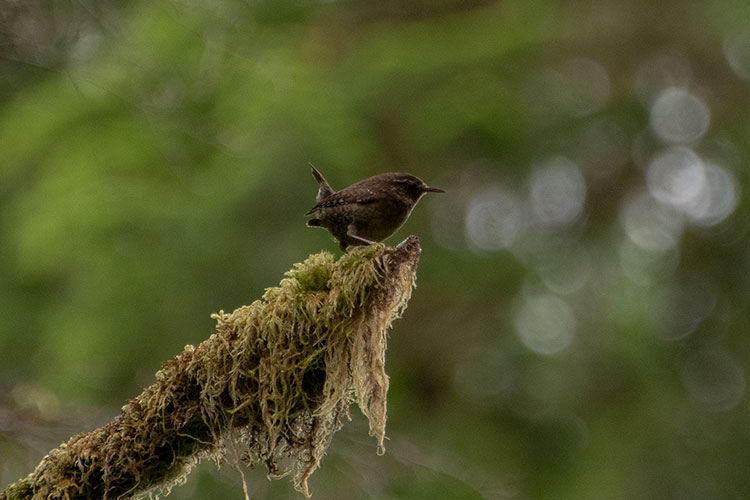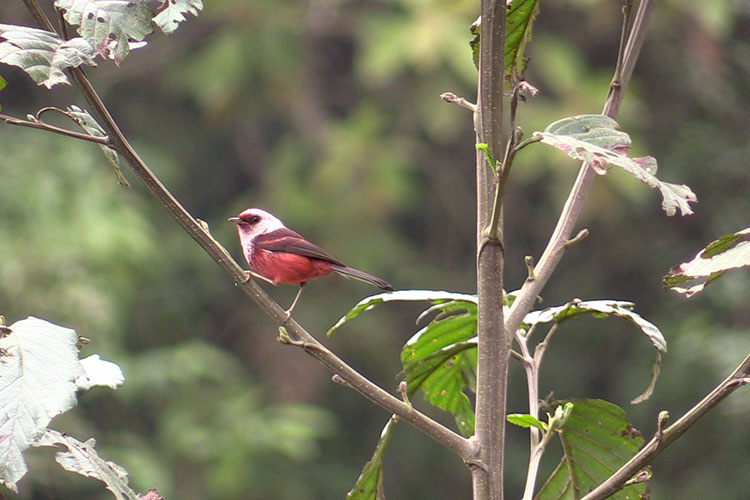Her out-of-office message should say ‘gone cuckoo’
Forget Twitter. Berkeley staffer follows nature’s chirps, trills and squawks
August 1, 2019
One of Melani King’s early forays into birding could have been the opening scene of a CSI episode.
As the dogged UC Berkeley web designer stalked a flock of gulls, crows and other scavengers along the Richmond shoreline, the dark mass she assumed to be a seal carcass turned out to be a boot with human tendons snaking out of it.
With trembling fingers, King hit 911 and told the dispatcher, “I think I’ve found a dead body.” The grisly find made the local newspaper’s crime blotter.

Melani King (right) birding on the Big Island in Hawaii. (Photo by Hulda Nelson)
While King has yet to learn the identity of the corpse she stumbled upon nearly a decade ago, today she can identify hundreds of avian species by the way they look, sound and behave. From casual bird-watcher to bona fide birder and citizen scientist, King rarely leaves home without her top-of-the-line Zeiss Victory binoculars.
“I can’t walk down the street or cross campus without noticing the birds and trying to identify them,” says King, 61, a California native and longtime resident of Richmond. “Birding has made my life so much richer.”
Her “life list,” a cumulative record of each species a birder has seen and accurately identified, catalogues more than 1,100 endemic and migrant birds in such exotic locales as Ecuador, Guatemala, Cambodia, New Zealand, Hawaii, Quadra Island and the Azores archipelago in the mid-Atlantic.
Here at Berkeley, she was among the first to spot the peregrine falcons nesting atop the Campanile.
So many birds, so little time
There are an estimated 10,000 species of birds worldwide and upward of 30 million birders. Unlike the hardcore members of her flock, King sees birding as more of a passion than a competitive sport.
“It’s highly unlikely I’ll get to 10,000 on my life list,” laughs King, who has worked at Berkeley’s Office of Communications and Public Affairs for 18 years.
Whether she’s gardening in her backyard, hiking in the California wilderness or bushwhacking through the jungles of South America, King’s ears are keenly attuned to chirps, trills and squawks.
“Did you hear that?” she’ll randomly ask in the middle of an outdoor conversation. “It’s a lesser goldfinch. They have such a plaintive song.” Or, she’ll remark on the “spiraling, ethereal song” of a Swainson’s thrush.

Townsend’s warbler bathing in fountain. (Video by Melani King)
And she’s always happy to partake in the ritual that birders perform when running into each other in the wilderness.
“If you see someone, and they’ve got binoculars, you say, ‘What are you seeing? Anything good?’ and usually they share what they’ve seen,” she says. “I’ve met a lot of really great people, who have pointed me to a lot of rare birds.”
She’s observed the courtship dance of Nebraska’s greater prairie chickens strutting around and raising their feathered horns, the flight of an albatross in New Zealand spreading its massive wings and taking flight, and Hawaii’s endangered I’iwi honeycreepers hopping through the rainforests.
In addition to predators, pollution and pesticides, climate change poses a major threat to dozens of bird species, many of which are struggling to adapt to warming temperatures that change their feeding, hibernation, mating and migration patterns.
Dark cloud of climate change
For birds that migrate to higher elevations, and for those that already occupy high altitudes and can’t fly much higher, the possibility of extinction is real. “It’s bad. They’ll die,” King laments.
Such bleak prospects make documenting bird species and observing their behaviors more critical than ever.
For her part, King regularly uploads her observations of birds, including photos and audio, to Cornell University’s e-Bird database, the premier crowdsourced repository of ornithological information. One of her favorite online destinations is the Cornell Lab of Ornithology’s Birds of North America website.
“I read everything I can about birds and love to study their behavior and habits,” says King, who video records birds eating, vocalizing and generally going about their daily lives.
Born in Long Beach, and of Osage and Cherokee native American ancestry, King earned a bachelor’s degree in fine arts from California State University, East Bay. It wasn’t until midlife that she developed a full appreciation for bird life.
Each morning, as she parked her car at the Richmond BART Station on the way to work, she’d hear a particular type of bird singing in a tree and got curious about it. The lyrical critter turned out to be a white-crowned sparrow, one of millions of winged migrants who travel the north-south Pacific Flyway that spans from Alaska to Patagonia in Argentina.
She began to carry binoculars and wildlife guides on road trips and overseas travel. But the big turning point came when she turned 50 and joined a birding field trip in Wildcat Canyon Regional Park in Richmond.
The guide, a descendant of former Berkeley Chancellor Robert Gordon Sproul, was able to identify a Pacific-slope flycatcher just by its call, and she was blown away.
“Because of that, I was determined to become adept at birding by ear,” she says.
‘Bird brain’ is no insult
So, through the Golden Gate Audubon Society, King took the class “Birding by Ear” three times, among others. She then advanced to an ornithology class at the College of Marin, where she learned everything from bird anatomy and physiology to migration.
At that point, she decided being called a “bird brain” was a compliment, not an insult.
“They’re so smart,” she says of birds, citing the heroic work of messenger pigeons during the wars, turkey vultures who can sniff out gas leaks and the V formation that migrating birds use to propel themselves along energy-saving air currents.
One Halloween, she dressed as a crow. On another, she was a hummingbird.
In 2013, King took her first official group birding trip to Ecuador, where she added 400 species to her life list, including the Andean cock-of-the-rock, with its scarlet head.

Lesser-ground cuckoo, Guatemala.
“It was overwhelming,” she says. “Bird heaven.”
After that, she went to Guatemala, then Hawaii and, most recently, to Quadra Island in British Columbia and Malheur National Wildlife Refuge in Oregon.
Next on her birding bucket list is Big Bend National Park in Texas, where more than 450 different species, including Mexican mallards, Mexican jays and Lucifer hummingbirds, make a stopover on their way south. She also wants to visit the jack pine forests of Michigan, where warblers gather.
So many birds, so little time.
“It takes over your life,” King says. “But there’s nothing I’d rather be doing.”
